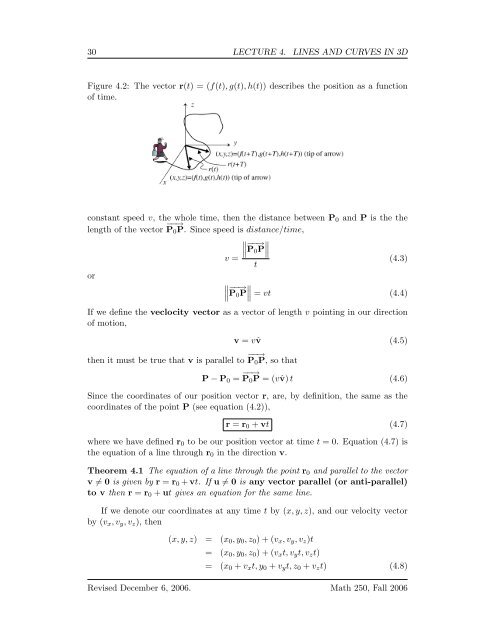Multivariate Calculus - Bruce E. Shapiro
Multivariate Calculus - Bruce E. Shapiro
Multivariate Calculus - Bruce E. Shapiro
You also want an ePaper? Increase the reach of your titles
YUMPU automatically turns print PDFs into web optimized ePapers that Google loves.
30 LECTURE 4. LINES AND CURVES IN 3D<br />
Figure 4.2: The vector r(t) = (f(t), g(t), h(t)) describes the position as a function<br />
of time.<br />
constant speed v, the whole time, then the distance between P 0 and P is the the<br />
length of the vector −−→ P 0 P. Since speed is distance/time,<br />
∥ −−→<br />
P 0 P∥<br />
v =<br />
(4.3)<br />
t<br />
or<br />
∥ −−→<br />
P 0 P∥ = vt (4.4)<br />
If we define the veclocity vector as a vector of length v pointing in our direction<br />
of motion,<br />
v = vˆv (4.5)<br />
then it must be true that v is parallel to −−→ P 0 P, so that<br />
P − P 0 = −−→ P 0 P = (vˆv) t (4.6)<br />
Since the coordinates of our position vector r, are, by definition, the same as the<br />
coordinates of the point P (see equation (4.2)),<br />
r = r 0 + vt (4.7)<br />
where we have defined r 0 to be our position vector at time t = 0. Equation (4.7) is<br />
the equation of a line through r 0 in the direction v.<br />
Theorem 4.1 The equation of a line through the point r 0 and parallel to the vector<br />
v ≠ 0 is given by r = r 0 + vt. If u ≠ 0 is any vector parallel (or anti-parallel)<br />
to v then r = r 0 + ut gives an equation for the same line.<br />
If we denote our coordinates at any time t by (x, y, z), and our velocity vector<br />
by (v x , v y , v z ), then<br />
(x, y, z) = (x 0 , y 0 , z 0 ) + (v x , v y , v z )t<br />
= (x 0 , y 0 , z 0 ) + (v x t, v y t, v z t)<br />
= (x 0 + v x t, y 0 + v y t, z 0 + v z t) (4.8)<br />
Revised December 6, 2006. Math 250, Fall 2006
















